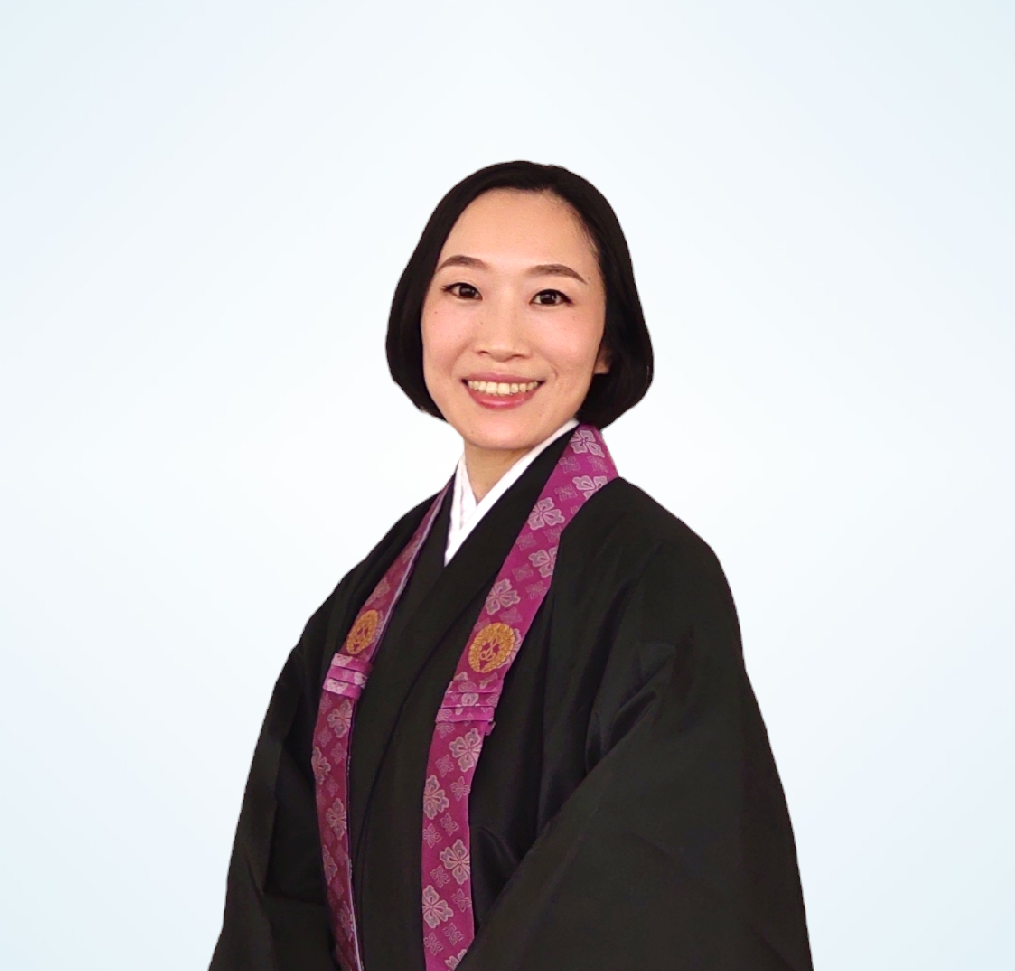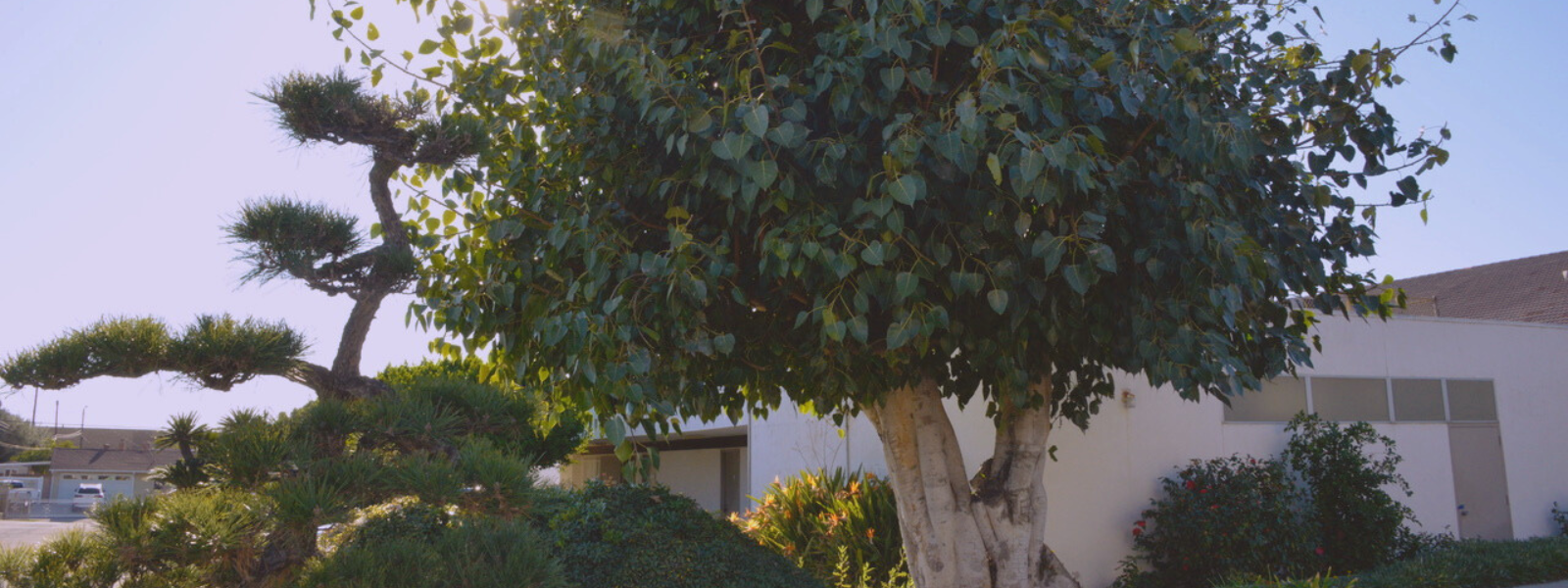Reflections of the Pure Land in Our Garden

Reverend Yukari Torii
Resident Minister, San Fernando Valley Hongwanji Buddhist Temple
At the end of April, we had a visit from students from Bert Corona Middle School next door to our temple. As I prepared for this field trip with sangha volunteers, I thought it would be a good opportunity to share my impressions of our temple garden with them. I strongly believe that this garden, as a temple of Jodo Shinshu, a sect of Pure Land Buddhism, holds not only beauty but also a very persuasive representation.
It’s been two months since Yoshikuni and I arrived in Los Angeles; I can’t believe it! The day following our arrival, we visited SFVHBT for the first time. I will never forget the impression I had of this temple on that day.
I perceive the garden of our temple in this way: when I first saw it, it reminded me of the landscapes of the Pure Land depicted in the Amida Sutra. For instance, there are jeweled trees, and each of the trees, arranged in seven rows, is adorned with a net of various jewels shining in their own colors. There is also a jeweled pond. In the water of this pond, gold, silver, and various jewels are scattered. And on the surface of the water, on the green leaves, flowers of blue, yellow, red, white, and green are blooming, each radiating beautiful light in their respective colors. The Amida Sutra refers to this scenery as:
There are lotus flowers, as large as chariot wheels, growing in the pools. Those of blue color emit blue radiance; those of yellow color emit yellow radiance; those of red color emit red radiance; and those of white color emit white radiance. (The Three Pure Land Sutras, Volume I: The Amida Sutra, p. 5, 2003)
It describes how each colored flower shines brightly with its respective light.
It is depicted as the ideal place that human beings can imagine. It is also depicted as a place where people in ancient India longed to be born. It’s about the world of enlightenment that can’t really be described by words, that goes beyond human imagination.
Therefore, the key point here is imagining the ideal world that each person aspires to and aiming for it. I’ve heard that one minister from the past expressed it this way: if the Buddha were to manifest the Pure Land for cats, it would be a world filled with catnip.
Whether it’s made of gold and silver treasures or catnip, the essence of the Pure Land is the enlightenment of the Buddha itself. Aspiration to be born there leads to seeking enlightenment. Seeking enlightenment then leads us to open our heart and mind to listen, to find ourselves “within enlightenment, within the heart of the Buddha.”
The ideal world I imagine is probably influenced by my personal preferences. In our temple garden, there are both Japanese and California-native plants. Each of those plants blooms beautifully in its own individuality while maintaining harmony. I perceive it as representing a world where there is no superiority or inferiority, and each individuality is appreciated.
This can also be seen as representing each of us shining with our respective colors without conflicting with others. This is the Third Vow out of Amida’s 48 Vows:
If, when I attain Buddhahood, the humans and devas in my land should not all be the color of genuine gold, may I not attain the perfect enlightenment. (The Three Pure Land Sutras, Volume II: The Larger Sutra, p. 20, 2009)
Amida Buddha (Bodhisattva Dharmakara: the former identity of Amida Buddha) made a pledge to make all residents of the Pure Land “be the color of genuine gold.” Genuine gold doesn’t literally mean the color gold. Rather, gold, being precious, signifies that everyone and everything shines as a precious existence in the Pure Land.
As human beings, we believe that having something superior in terms of appearance, abilities, and social status, etc., is a condition for a better and brighter life. I myself used to struggle with not being able to accept my true self, comparing myself to others, and harboring thoughts like, “If only I were more beautiful, smarter, or wealthier, I could live more happily,” which only caused me distress due to the gap between reality and the ideal.
Unless we are liberated from comparing ourselves with others, we cannot regain our true brilliance. However, as I delve into the teachings of Jodo Shinshu, I naturally come to think that it’s okay to love myself just as I am. Of course, having goals and striving towards them is wonderful. However, it should not be for the sake of comparison with others but rather for being oneself and enjoying the process of doing it.
In our temple garden, various plants of different origins shine individually while coexisting beautifully. That reminds me of the Pure Land. It may only be a representation of the ideal world as imagined by human beings. However, I feel that I can see this worldview reflecting my ideals within this Sangha as well. Even in activities like DME, each member enjoys showcasing their talents, and others participate in their own enjoyable ways. For instance, at Spring Fling, some danced, some enjoyed watching others dancing, some enjoyed the music, and some enjoyed chatting with friends who were gathered there.
In our temple, we can at least imagine a world of enlightenment where we acknowledge each other’s individuality, respect each other without comparison, and coexist harmoniously, from both our garden and our activities, can’t we? Then, listening to the teachings about such a world of enlightenment leads us to live bowing our heads with humility, much like the appearance of wisteria flowers, with gratitude for both interconnectedness and supporting each other.
Judy gave a comment after I shared my impression of the garden during the preparation for the field trip:
As humans, we may be various colors, shapes, and sizes, but we all radiate light and beauty, no one superior or inferior, and all have value and are appreciated. This thinking is only possible if we show humility, bow our heads like the wisteria, and express gratitude for the opportunity to live individually in harmony together.
We listen to this teaching again and again, that everything is interconnected and coexisting within the heart of Amida Buddha or within enlightenment. I believe, thus, that each member here naturally creates an environment where we become aware of this fact. I am very grateful to be able to engage in the activities with all of you here in San Fernando temple.
Lastly, it was truly wonderful to share ideas and collaborate with those who worked so hard on the Bert Corona Field Trip. Thank you again for your tremendous help. Namo Amida Butsu.
Gassho

